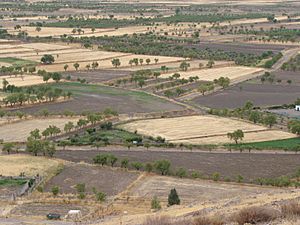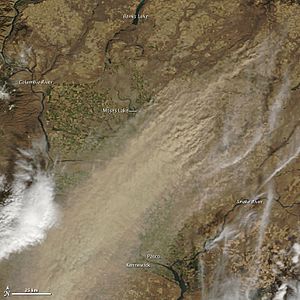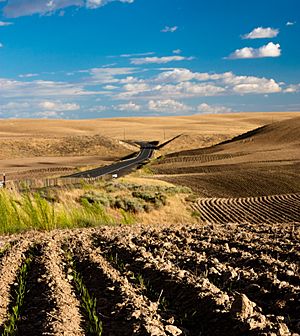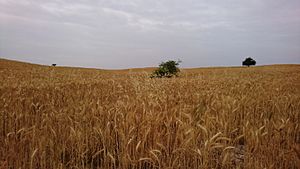Dryland farming facts for kids

Dryland farming (also called dry farming) is a special way of growing crops without using irrigation. This means farmers rely only on natural rainfall to water their plants. It's used in places called drylands, which have a cool, wet season that fills the soil with water, followed by a warm, dry season. It's also common in very dry areas or places where water is hard to find.
What is Dryland Farming?
Where is Dryland Farming Used?
Dryland farming is practiced all over the world. You can find it in the Great Plains of the United States, like the Palouse plateau in Eastern Washington. It's also used in other dry parts of North America, such as the Southwestern United States and Mexico.
Beyond North America, it's common in the Middle East and in grain-growing areas like the steppes of Eurasia and Argentina. In Australia, dryland farming is widely used in almost all states.
What Crops Grow Well?
Many different crops can be grown using dryland farming. These include winter wheat, maize (corn), beans, sunflowers, and even watermelon.
Believe it or not, successful dryland farming can happen with as little as 230 millimeters (9 inches) of rain a year! More rain means farmers can grow a wider variety of crops. Ancient Native American tribes in the dry Southwest managed to farm for thousands of years with less than 250 millimeters (10 inches) of rain.
The best crop depends on when most of the rain falls. For example, winter wheat grows well where winters are wet. Areas with rainy summers might grow crops like sorghum, sunflowers, or cotton.
How Does it Work?
Dryland farming involves special techniques to make the most of the water available. Farmers constantly check how much moisture is in the soil. They plan their crops based on this.
It's a challenging way to farm because rainfall can be unpredictable. Farmers need to be financially strong to handle years when crops might fail. They must manage their money carefully to reduce losses during dry years. In good years, when there's enough rain, they try to get the best possible harvest to make up for the dry years.

Because dryland farming relies on natural rainfall, the soil can sometimes be left open to dust storms. This happens especially if farming methods are not good, or if storms hit at a bad time. Farmers often leave fields empty for a period (called fallow). This helps the soil store water, but it also means the ground isn't always covered by plants. A cover crop would normally protect the soil from erosion.
Some old ideas about dryland farming, from the late 1800s and early 1900s, turned out to be wrong. For example, some thought that tilling (turning over) the soil would seal in moisture. This idea, called "dust mulching," didn't work in real tests. Many people who tried to farm in very dry areas based on these ideas failed.
Catching and Saving Moisture
In some places, like Eastern Washington, a dryland farm might get only 216 millimeters (8.5 inches) of rain each year. In the Horse Heaven Hills, wheat has grown with only about 150 millimeters (6 inches) of rain! So, farmers must catch and save every bit of moisture until the plants can use it.
One technique is summer fallow rotation. This means a crop grows using two seasons' worth of rain. Farmers leave leftover plant parts (stubble) in the field. This helps trap snow and prevents water from running off. They also use terracing fields. Terracing means shaping the land into steps or ridges. Farmers also plow along the natural curves of the land (called contour plowing) to slow down water runoff. They save moisture by removing weeds and leaving crop residue to shade the soil.
Using Moisture Wisely
Once water is in the soil, plants need to use it as effectively as possible. Farmers carefully choose when and how deep to plant seeds. They put seeds where there is enough moisture, or where it will be when the seasonal rains come.
Farmers often pick plant types that can handle dry conditions and heat. These might not produce the most crops, but they are more likely to survive if there isn't much rain. This helps farmers protect their harvest if the seasonal rain doesn't come.
Protecting the Soil
Dryland farming can make soil very vulnerable to erosion, especially from wind. Some methods that save water (like tilling to kill weeds) can actually harm the topsoil. Since healthy topsoil is vital for long-term farming, protecting it is a top goal.
Farmers use techniques like windbreaks (rows of trees or shrubs), reduced tillage (less plowing), or no-till farming. They might also spread straw or other materials on the ground. Strip farming (growing crops in long strips) also helps reduce topsoil loss.
Managing Costs
Dryland farming is done in areas where farming without irrigation is naturally difficult. This means there's a higher chance of crop failure or low yields in a dry year. Farmers must constantly check how well their crops are growing. If it looks like there won't be enough moisture, they might reduce how much fertilizer or weed control they use. This helps them save money. But in good years, when there's plenty of rain, farmers might spend more to get the biggest harvest possible. This helps them balance out the bad years.
Dry Farming (Specific Type)
Where is Dry Farming Used?
Dry farming can be done in places that get a lot of rain during a wet season, often in winter. Then, crops are grown during the dry season that follows. They use the water stored in the soil from the wet season. In the United States, states like California, Colorado, Oregon, and Wyoming use dry farming for various crops.
What Crops Grow Well?
Crops grown with dry farming can include grapes, tomatoes, pumpkins, and beans. These plants grow using the winter rain stored in the soil, instead of needing rain during the summer growing season.
How Does it Work?
Dry farming focuses on using the "bank" of water stored in the soil from winter rains. Some methods include:
- Wider Spacing: Plants are spaced farther apart than usual. This gives each plant more soil moisture to use.
- Minimal Tilling: Farmers disturb the soil as little as possible.
- Weed Control: Weeds are strictly controlled. This ensures they don't use up water that the crops need.
- Soil Cultivation: Sometimes, the soil is tilled to create a "dust mulch." Some believe this stops water from evaporating from the soil. However, this idea is debated and not all farmers use it.
- Crop Choice: Farmers choose specific crops and plant types that are well-suited for dry farming conditions.
Images for kids
See also
 In Spanish: Agricultura de secano para niños
In Spanish: Agricultura de secano para niños




